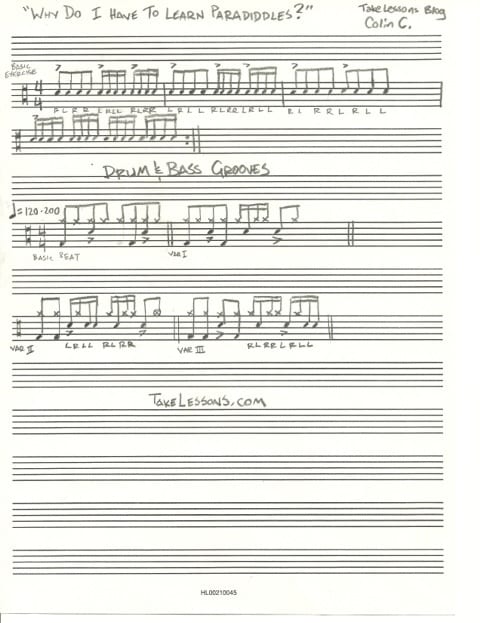Just how important is practicing drum rudiments, such as paradiddles? Exercises like these help you learn control and accuracy, to begin with. As you continue your studies, you’ll be able to incorporate rudiments into your everyday playing to create awesome fills and drum solos.
Learning to play the drums is a fun and rewarding experience. To become a great drummer, you need to practice regularly and develop your skills.
One of the best ways to practice drumming is by learning paradiddles, which are short exercises designed to help drummers develop their technique and speed.
In this blog post, we’ll discuss why it’s important for drummers to learn paradiddles and how to practice them effectively.
What Are Drum Paradiddles?
So what are paradiddles? Drum paradiddles are a series of rhythmic combinations used to develop control and finesse on the drums:
- They involve two-handed sticking patterns beginning with one part of the hand, such as the index finger, then alternating between each hand starting with the same element each time.
- Drum paradiddles can increase coordination between a musician’s arms, help create speed and agility, and enable them to express themselves confidently during creative sections of their performance.
- Some drummers also use different variants or/and add rudiments for variations in note lengths to further enhance their development in drumming.
Paradiddles are an integral part of marching band drumlines and advanced techniques employed by professional drummers alike.
Want to learn more about the drum paradiddle – and other drum rudiments that can help you improve as a drummer? Sign up for drumming lessons – and check out the helpful video below:
https://www.youtube.com/watch?v=_6R2QeM3fBA
Why is it Called a Paradiddle?
The paradiddle is an important rudiment frequently used in drumset playing. It got its name from a combination of two existing words: “parallel” and “riddle”. The reason for this is that the main component of the paradiddle is a double stroke consisting of two notes played in quick succession, thereby forming a short parallel pattern.
Limited sources account for why it was given the ‘diddle’ component, but many theorize that it may have been due to the fact that patterns created by the paradiddle resemble a riddle.
Whatever its origin may be, we now have this fun and useful rudiment to add whimsicality and musicality to our drumming.
What is a Paradiddle Pattern?
A paradiddle pattern is a type of drum rudiment created by adding two single strokes to one group of four strokes. This creates a repeating rhythmic pattern with an alternating loud and soft beat. A paradiddle can be played on any drum or percussion instrument, such as bongos, timbales, and congas.
Generally speaking, a paradiddle will play on the snare drum with P’s and T’s (drummers often refer to p for the left hand and t for the right when practicing rudiments).
By playing this pattern around the drum set at different levels and rhythms it allows for greater creativity within each drummer’s unique style and sound.
What Are Some Paradiddle Drum Exercises?
Whether you’re a beginner or a seasoned drummer, there’s no denying that mastering the paradiddle is one of the most important drum exercises. A paradiddle is a rhythmic pattern that combines different combinations of single and double strokes on the drum. It’s used to develop hand speed and coordination in drummers.
Here are some of the most popular paradiddle drum exercises.
Double Paradiddle
The double paradiddle is perhaps one of the most popular paradiddles as it combines both single and double strokes. This exercise consists of alternating hands with two singles followed by a double stroke on each side. This exercise can be played in many different ways, such as slow or fast tempos or even in reverse order. It helps to increase coordination between both hands, improving your overall playing ability.
Paradiddle Tap
The paradiddle tap is an interesting variation on the standard paradiddle. Instead of starting with two singles followed by a double stroke, this exercise starts with a single stroke followed by two doubles. This allows for increased speed and control when playing faster songs or fills. It also requires more focus and control as it requires you to keep your left hand steady while allowing your right hand to move freely across the drums.
Other Exercises
There are other variations of the paradiddle drum exercise that can be used to improve your skills on the drums such as the flamadiddle, ratamacue, and inverted paradiddles just to name a few.
Each variation focuses on different elements such as speed, accuracy, stamina, and coordination so it’s important to choose an exercise that fits your skill level and musical style best. Experimenting with different variations can help you find new ways to improve your overall playing ability!
How to Improve Paradiddles
Here are some tips and tricks on how to improve paradiddles.
Stick Height and Posture
The first step in improving paradiddles is to ensure you have good posture and stick height. If your sticks are too low or too high, it will make playing harder than necessary. You should be sitting in a comfortable position with your elbows bent at about 90 degrees. Your sticks should be level with the snare drum when held in the air, slightly above it when striking the drums. Make sure you maintain this posture throughout your practice session.
Practice Slow
When practicing paradiddles, it’s best to start slow. Focus on perfecting each stroke rather than trying to play as fast as possible from the outset. Once you have a good feeling for the pattern, slowly increase the tempo until you reach a speed where your hands and feet feel comfortable playing together without any mistakes. This will help build muscle memory so that you can eventually play faster without thinking about the individual strokes each time.
Break It Down
If you’re having trouble getting used to playing paradiddles, one way to make it easier is to break them down into smaller patterns. For example, instead of playing a single 8-note phrase, break it up into two 4-note phrases or four 2-note phrases and practice those separately before putting them back together into one big phrase again. By doing this, you can focus on mastering smaller sections of the pattern first before building up to larger ones later on in your practice sessions.
Learn Every Drum Paradiddle You Need to Know
Now that you know what a drum paradiddle is and how to improve your skills, you’re ready to take the next step as a drummer.
Want to learn more? Chicago teacher Colin C. offers up his advice in today’s exclusive podcast. The paradiddle is just one of the essential rudiments, but it’s a great one to focus on. Print out the image below so you can follow along with the paradiddle exercises, and then click here to listen to the podcast.

 Colin C. teaches drum, music recording and percussion lessons to students in Chicago, IL. He specializes in rock and jazz styles, and several different percussion instruments including marimba/xylophone, timpani, concert percussion and world percussion. He joined the TakeLessons team in October 2012. Learn more about Colin, or visit TakeLessons to find a teacher near you!
Colin C. teaches drum, music recording and percussion lessons to students in Chicago, IL. He specializes in rock and jazz styles, and several different percussion instruments including marimba/xylophone, timpani, concert percussion and world percussion. He joined the TakeLessons team in October 2012. Learn more about Colin, or visit TakeLessons to find a teacher near you!
Photo by PeterTea
Suzy S.

